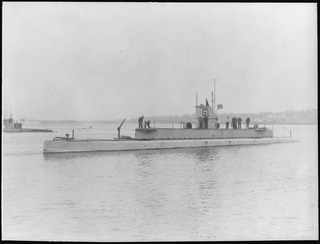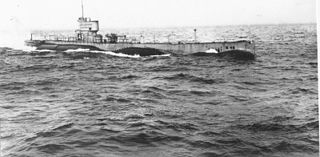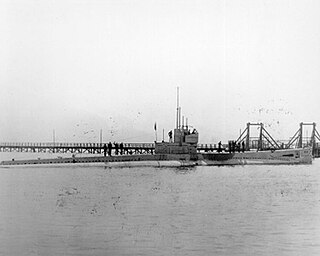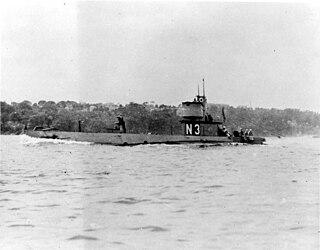
USS G-1 (SS-19½) was the lead ship of her class of submarine of the United States Navy. While the four G-boats were nominally all of a class, they differed enough in significant details that they are sometimes considered to be four unique boats, each in a class by herself.

USS S-49 (SS-160) was a fourth-group (S-48) S-class submarine of the United States Navy.

USS S-48 (SS-159) was the first submarine in the fourth group of S-class submarines of the United States Navy.

USS R-9 (SS-86) was an R-class coastal and harbor defense submarine of the United States Navy.

USS R-23 (SS-99) was an R-class coastal and harbor defense submarine built for the United States Navy during World War I.

USS R-21 (SS-98) was an R-class coastal and harbor defense submarine of the United States Navy. Her keel was laid down on 19 April 1917 by the Lake Torpedo Boat Company in Bridgeport, Connecticut; the R-boats built by Lake Torpedo Boat are sometimes considered a separate class from those built by Fore River Shipbuilding and Union Iron Works. She was launched on 10 July 1918 sponsored by Mrs. Dallas C. Laizure and commissioned on 17 June 1919.

USS O-13 (SS-74) was an O-class submarine of the United States Navy. Her keel was laid down on 6 March 1916 by the Lake Torpedo Boat Company in Bridgeport, Connecticut.

USS N-1 (SS-53) was a N-class coastal defense submarine built for the United States Navy during World War I.

USS N-2 (SS-54) was a N-class coastal defense submarine built for the United States Navy during World War I.

USS N-3 (SS-55) was a N-class coastal defense submarine in commission in the United States Navy from 1917 to 1926. She saw service during World War I.

USS N-5 (SS-57) was a N-class coastal defense submarine of the United States Navy. Her keel was laid down on 10 April 1915 by Lake Torpedo Boat Company in Bridgeport, Connecticut. The N-boats built by Lake had slightly different specifications from the ones built by Seattle Construction and Drydock and are sometimes considered a separate class.

USS N-6 (SS-58) was a N-class coastal defense submarine of the United States Navy. Her keel was laid down on 15 April 1915 by Lake Torpedo Boat Company in Bridgeport, Connecticut. The N-boats built by Lake had slightly different specifications from the ones built by Seattle Construction and Drydock and are sometimes considered a separate class.

USS N-7 (SS-59) was a N-class coastal defense submarine built for the United States Navy during World War I.

USS G-4 (SS-26) was a G-class submarine of the United States Navy. While the four G-boats were nominally all of a class, they differed enough in significant details that they are sometimes considered to be four unique boats, each in a class by herself.

USS G-2 (SS-27) was a G-class submarine of the United States Navy. While the four G-boats were nominally all of a class, they differed enough in significant details that they are sometimes considered to be four unique boats, each in a class by herself. G-2 was named Tuna when her keel was laid down on 20 October 1909 by the Lake Torpedo Boat Company in Bridgeport, Connecticut, making her the first ship of the United States Navy to be named for the tuna, a large, vigorous, spiny-finned fish highly esteemed for sport and food. She was renamed G-2 on 17 November 1911, launched on 10 January 1912 sponsored by Ms. Marjorie F. Miller, towed to the New York Navy Yard after the termination of the Lake contract on 7 November 1913 where she was completed, and commissioned on 1 December 1913.

USS G-3 (SS-31) was a G-class submarine of the United States Navy. While the four G-boats were nominally all of a class, they differed enough in significant details that they are sometimes considered to be four unique boats, each in a class by herself. G-3 was named Turbot when her keel was laid down on 30 March 1911 by the Lake Torpedo Boat Company in Bridgeport, Connecticut, making her the first ship of the United States Navy to be named for the turbot, a large, brown and white flatfish, valued as a food. She was renamed G-3 on 17 November 1911, transferred to the New York Navy Yard for completion on 17 November 1913 following the cancellation of the Lake contract, launched on 27 December 1913, and commissioned on 22 March 1915.
USS Semmes (DD-189/AG-24) was a Clemson-class destroyer in the United States Navy during World War II. She was the first Navy ship named for Commander (USN), Rear Admiral (CSN), Brigadier General (CSA) Raphael Semmes (1809–1877).
The Lake Torpedo Boat Company of Bridgeport, Connecticut, was an early builder of submarines for the United States Navy in the early 20th century.

The United States Navy's sixteen O-class submarines were created out of the lessons learned from the L class. The O class were about 80 tons larger than the L class, with greater power and endurance for ocean patrols. Due to the American entry into World War I the O class were built much more rapidly than previous classes, and were all commissioned in 1918. O-1 through O-10 were group 1, designed by Electric Boat, O-11 through O-16 were group 2, designed by the Lake Torpedo Boat Company and sometimes considered a separate class. The group 2 boats entered service just before the end of World War I. Eight of the group 1 boats survived to serve in World War II as training boats when they were recommissioned in 1941.

USS Lykens (SP-876/AT-56) was a steam tugboat purchased from the Reading Company by the United States Navy in 1917. Because she was privately built, she was not of a ship class. She was the only U.S. Navy ship of this name.


















